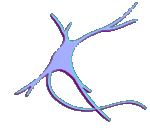 I will start this tutorial with a quote from two eminent electrophysiologists
in the study of ion channels:
I will start this tutorial with a quote from two eminent electrophysiologists
in the study of ion channels: I will start this tutorial with a quote from two eminent electrophysiologists
in the study of ion channels:
I will start this tutorial with a quote from two eminent electrophysiologists
in the study of ion channels:
Our ability to do gymnastics, to perceive a colorful world, and to process language relies on rapid communication among neurons. Such signaling, the fastest in our bodies, involves electrical messages produced as ion channels in cell membranes open and close. Various ion channels mediate sensory transduction, electrical "computations", propagation over long distances, and synaptic transmission (Clay M. Armstrong and Bertil Hille, Neuron 20: 371-380, 1998).
This first module of the tutorial will give general overview of ion channels, what they are and what they do. Hopefully, this will be largely a review of what you have learned in earlier courses.
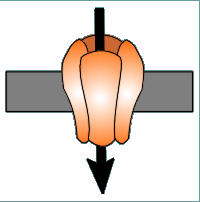 Ion channels
are membrane bound proteins which allow ions to flow into or out of cells.
Ion channels
are membrane bound proteins which allow ions to flow into or out of cells.
They are usually constructed from 4 or 5 different protein subunits.
These subunits form a ring the center of which is an ion pore.
Shown here is an ion channel on the membrane constructed from individual subunits.
The arrow is showing the pore through which ions will flow if the channel is open.
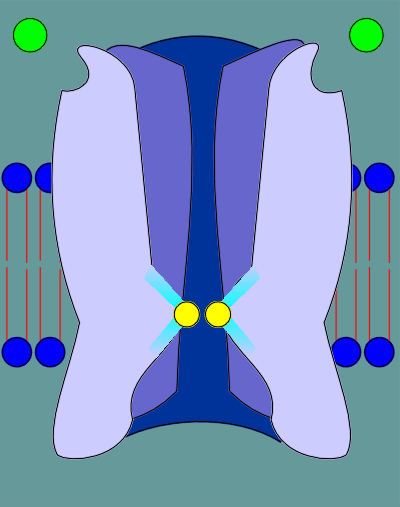 There are two major
classes of ion channels, those that are induced to open through the binding of a ligand
and those that are induced to open by a change in membrane potential.
There are two major
classes of ion channels, those that are induced to open through the binding of a ligand
and those that are induced to open by a change in membrane potential.
The first group are referred to as ligand-operated or ligand-gated ion channels.
The second group are referred to as voltage-operated or voltage-gated ion channels.
On the right is a side view through the middle of a ligand-operated channel.
The ligand (green circle) binds to specific sites in extracellular side of the ion channel.
As a consequence of this binding "gates" deep within the receptor are induced to open and thus ions can flow through the channel.
Ligands are usually small molecules neurotransmitters such as acetylcholine, glutamic acid or gamma aminobutyric acid (GABA).
_____________
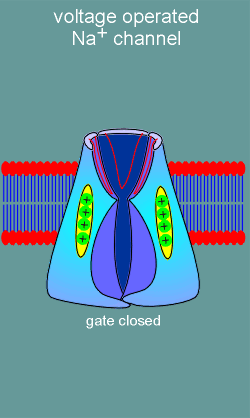 For the second major class of ion
channels, the voltage operated channels, there are no ligand binding sites.
For the second major class of ion
channels, the voltage operated channels, there are no ligand binding sites.
Rather, these ion channels possess voltage sensors (structure with positive charges in figure to left).
With membrane depolarization (yellow arrows) the voltage sensors move and, in doing so, induce opening of an ion gate on the intracellular side of the channel.
Ions are now free to flow into or out of the cell (in this example the channel is a Na+ channel and thus Na+ flows into the cell).
The structure and functioning of voltage-operated ion channels will be covered in greater detail in the module "the Neuron" of this tutorial.
Ion channels are constructed from discrete proteins called "subunits".
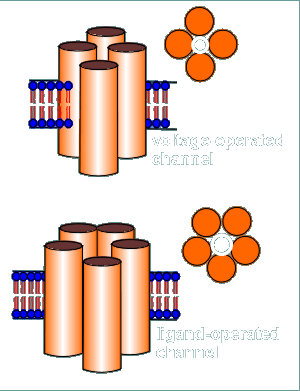 Voltage-operated channels are generally constructed from
4 subunits whereas ligand-operated ion channels are constructed from 5 subunits.
Voltage-operated channels are generally constructed from
4 subunits whereas ligand-operated ion channels are constructed from 5 subunits.
Shown to the right is a representation of voltage-operated and ligand-operated channels where each subunit is represented by a cylinder in the lipid bilayer (blue circles and red tails represent phospholipids of the bilayer).
By looking straight down on the channel, depicted on the far right, you can get an impression of the size of the pore (indicated as white circle).
Note that because the ligand-operated channel has more subunits its pore is larger than that of a voltage-operated channel.
Because of the larger pore the ligand-operated channel is, in general, less ion specific that the voltage-operated channel.
For example, one of the very important ligand-operated ion channels is the so-called NMDA receptor (you will hear more about this receptor later in this tutorial).
This receptor is a Ca2+ channel but a considerable amount of Na+ also enters the cell via the receptor when the channel has opened.
Ion channels are usually quite specific for the ion which they allow to pass through the pore. Thus we speak of Ca2+ channels, Na+ channels, K+ channels and Cl- channels.
Ion specificity is largely determined by ion filters constructed within the channels.
 The direction an ion goes (into or
out of the cell) depends on the so-called electrochemical equilibrium point for the ion.
The direction an ion goes (into or
out of the cell) depends on the so-called electrochemical equilibrium point for the ion.
The electrochemical equilibrium takes into account both the concentration gradient and the charge of the ion.
The ion will flow into or out of the cell until it reaches its electrochemical equilibrium point.
To explain further it is important to remember that a cell normally has a resting potential of between -50 to -70 mV.
Thus positive charges tend to be pulled into the cell and negative charges pulled out (this is the "electro" part of the electrochemical equilibrium point).
However, for the K+ ion the concentration of the ion is far higher in the cell than outside and thus, with opening of a K+ channel the ion flows out.
This is why it is important to consider both the charge and the concentration (i.e. the electrochemical equilibrium point of the ion) when deciding which way an ion will travel.
Shown below are the usual directions of flow for various ions (the intensity of the colors gives an impression of the concentration gradients between the extracellular (top) and intracellular (bottom) compartments.
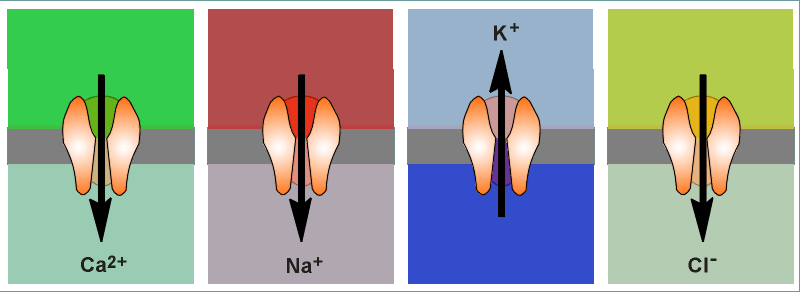
Opening of Ca2+ and Na+ channels cause the cell to become less negative inside, thus a depolarization and an activation of the cell.
Opening of K+ and Cl- channels cause the cell to become more negative inside, thus a hyperpolarization and an inhibition of the cell.
Note that the Cl- ion, like the K+ ion, travels with the chemical gradient and against the electro-gradient.
In some cells the electrochemical equilibrium point for Cl- is such that Cl- flows in fact out of the cell (against the concentration gradient!)
In this case opening of the Cl- channel leads to a depolarization and activation of the cell rather than the normal hyperpolarization and inhibition of the cell.
This again illustrates the importance, for each cell, to consider the electochemical equilibrium point and not just the concentration gradient of an ion when considering what the ion will do when the ion channel opens.
What keeps ions from slowly diffusing (leaking) to their electrochemical equilibrium point and thus the cell loosing its resting membrane potential?
The answer, nothing!...... and thus the cell must be constantly pumping ions to maintain the electrochemical gradients.
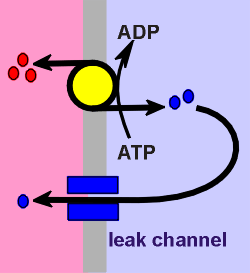 As an example,
consider Na+ and K+, the two ions that make the most important contribution in determining
the membrane potential.
As an example,
consider Na+ and K+, the two ions that make the most important contribution in determining
the membrane potential.
Na+/K+ ATPases are constantly active in the membrane, pumping 3 Na+ ions out for every 2 K+ ions in (red and blue circles respectively in figure to left).
This already makes the inside of the cell more negative than the outside (3 + charges pumped out for every two + charges pumped in).
Additionally, there are so-called "K+ leak channels" on the membrane which allow some of the K+ ions to leak out (down the electrochemical gradient).
This leakage makes the cell even more negative inside and thus we arrive at a rest potential of -50 to -70 mV.
All this pumping costs energy, energy derived from ATP-hydrolysis.
Thus the name for this pump is Na+/K+-ATPase.
In the remaining modules of this tutorial you will be introduced to three important classes of ligand-gated ion channel receptors, namely the nicotinic receptor, the GABAa receptor and ion channel receptors for the neurotransmitter glutamate.
 This is
the end of the module "What are Ion Channels?"
This is
the end of the module "What are Ion Channels?"